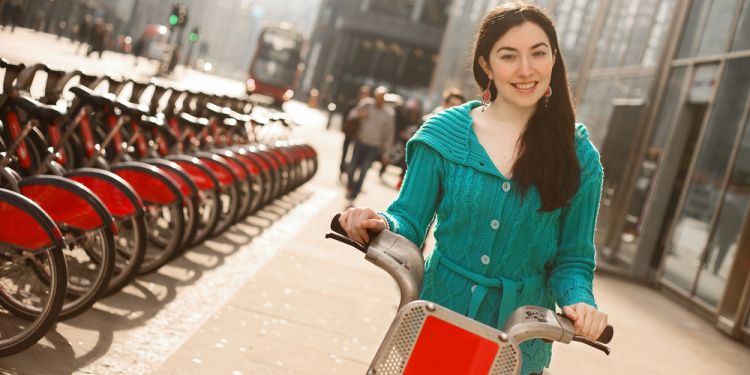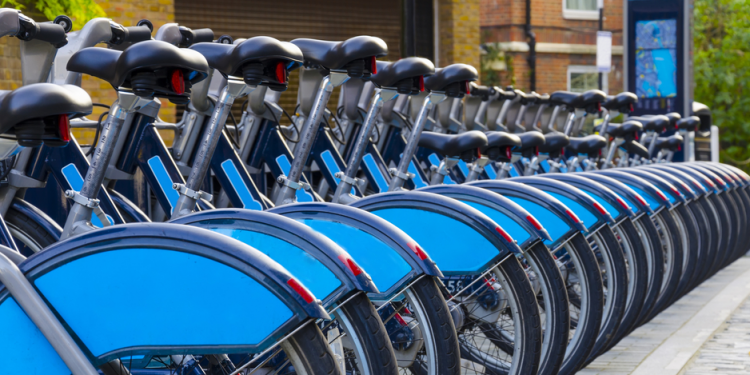The explosion of bike sharing

The recent explosion in the number of bike sharing schemes around the world has provided a reliable alternative to the issue of investing in your own bike. These schemes take one of two forms — either rows of bicycles in specific docking stations or random bikes dotted around a town that can be unlocked and used via a mobile app. It is this second type that allows tremendous flexibility, as they can be picked up and dropped off at random locations, including outside your work or home.
Biking to work has been popular for long in some major cities such as Amsterdam where the percentage of people who own a bike is relatively high. For the rest of us, the prospect of cycling to work often brings up questions of both safety and pricing. Is it worth buying a bike to cycle to work in wet London? Is it safe to ride a bike around in large, sprawling cities built to handle high volumes of regular traffic?
Dr Elliot Fishman, Director of the Institute for Sensible Transport, Australia says: “…bike share is cheap for the end user. A rider who purchases an annual membership is basically paying about 25 cents per day, for unlimited amounts of trips, as long as each trip is 30 minutes or less. This is a very good deal and is part of the reason so many people in some cities have chosen to sign up. The reason people use bike share is because it makes their travel experience more convenient. It transforms a 20-minute walk into a five-minute bike trip. When this occurs twice a day, five days per week, it adds up to a lot (a travel time saving of about 130 hours a year).”
Commuting to work

As cities become megacities, workers are forced to move away from the centre and towards the outskirts. This also means increasing commute times for many of us, whether we move away as a sacrifice for bringing our children up in a nicer environment, or are forced out by ever increasing rent. For those that live in these environments, inexpensive bike sharing services provide a healthier and cheaper alternative to the more traditional overcrowded public transport systems.
Clint, a Canadian expat in China says: “I was recently in Shanghai on business and could not help but notice the number of bicycles available and the considerable number of people making use of them, even in the very late hours of the evening. The concept seems to have really taken hold. This is in sharp contrast to what I witnessed in places like Quito in Ecuador, where hardly anyone made use of the service.”
In China and much of Europe, getting people to choose the greener mode of transport has not been difficult, but in some cities, the uptake has not been as significant as in others. For example, in the Netherlands, many of the schemes are poorly utilised for obvious reasons — the Netherlands has a long-standing culture of cycling, with 36% of residents listing the bicycle as their most frequent mode of transport. In cities where bikes are already affordable, low-cost hire only makes a tiny difference to the population.
In megacities that have adopted bike sharing wholeheartedly, this new method of bicycle access is opening up whole neighbourhoods for potential homeowners. In the past, many would only consider buying or renting a home that was a short distance from a public transport hub. But public hire bikes has changed that allowing many to access more affordable housing, away from the more highly populated, accessible, and expensive areas.
Curiously, India has relatively few bike sharing schemes for its size, especially when compared to China. Although striving towards their goal of ‘moving people, not vehicles', the development of the large schemes for megacities such as the ones seen in China and Japan, has been exceptionally slow. Some have criticised the Indian government for being too slow at bringing in large-scale initiatives to get people cycling. Currently, we estimate India has a total of around 300 public hire bicycles, a stark contrast to China's figure of somewhere over a million.
Cycling for longer life

Regardless of how well governments are at pushing and encouraging their populations to move their commute onto two wheels, a primary concern for many is still the safety aspect. Many see cycling as a much more dangerous prospect than taking public transport, especially at rush hour and in big cities, where roads are congested, and larger vehicles are innumerate. In some ways, this is a valid concern, but don't forget the health benefits of the regular exercise.
A simple comparison of calories burned by different methods of commuting shows just how much better cycling is for your health than the more common modes of transport. Cycling through rush hour speed traffic can burn around four times more calories than taking the car, bus or train. When compared to spending 30 minutes on the treadmill in the gym, cycling to work seems like a much better use of time.
Undoubtedly, there is a risk of an accident occurring when cycling in busy traffic, but studies have found that bike-sharers are less likely to be involved in accidents than normal cyclists, even though they have a lower usage of safety clothing (high visibility jackets and cycling helmets). Multiple explanations have been offered for this, including the fact that the bikes are often sturdier and better maintained, and that users of these bikes are often more cautious than regular bike owners.
Sources :
- Expat Finder : http://www.expatfinder.com/
















